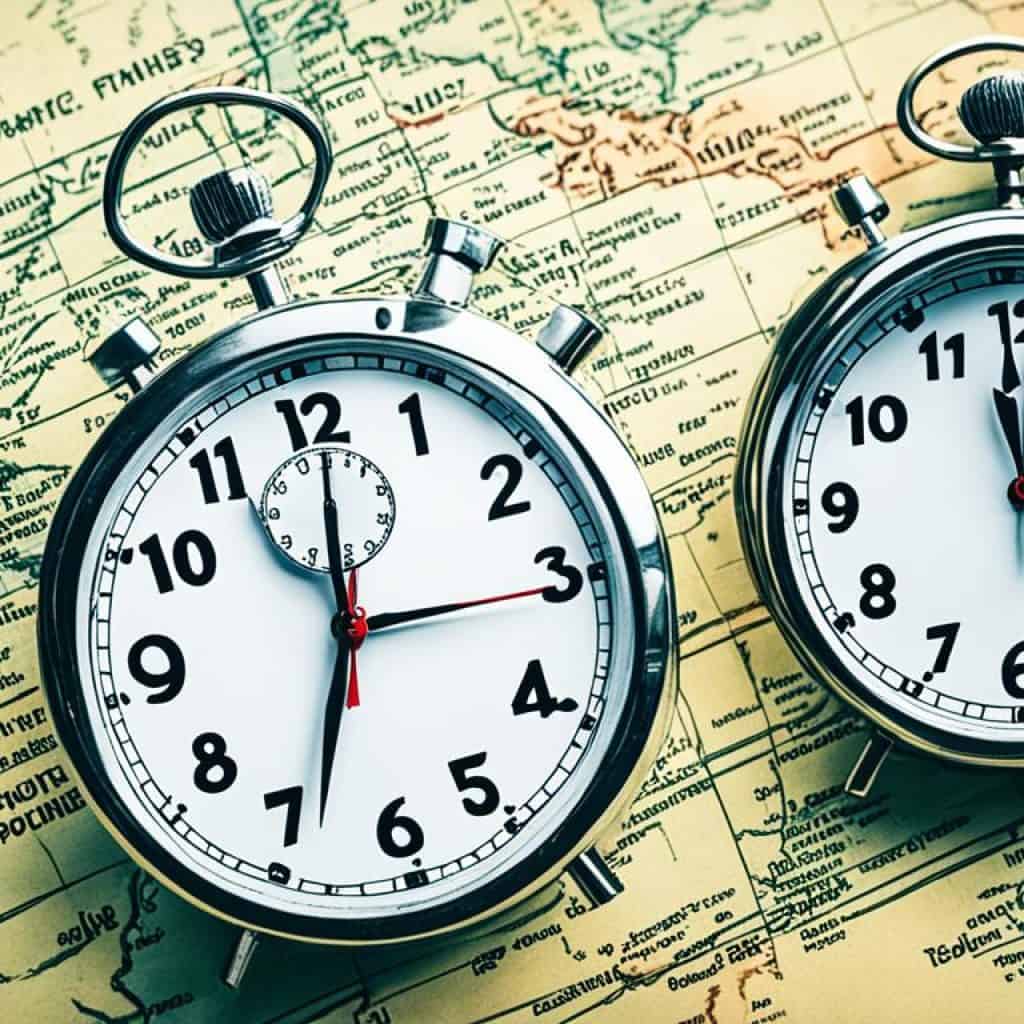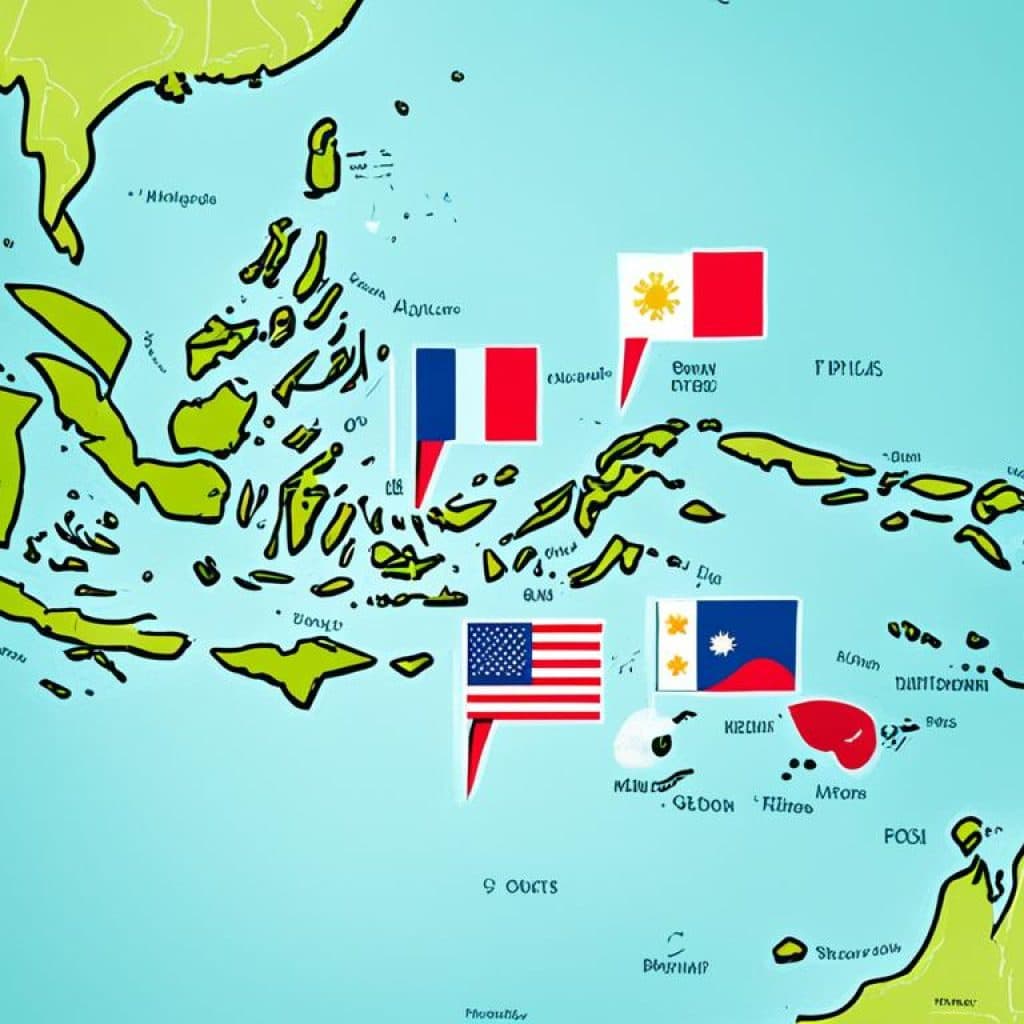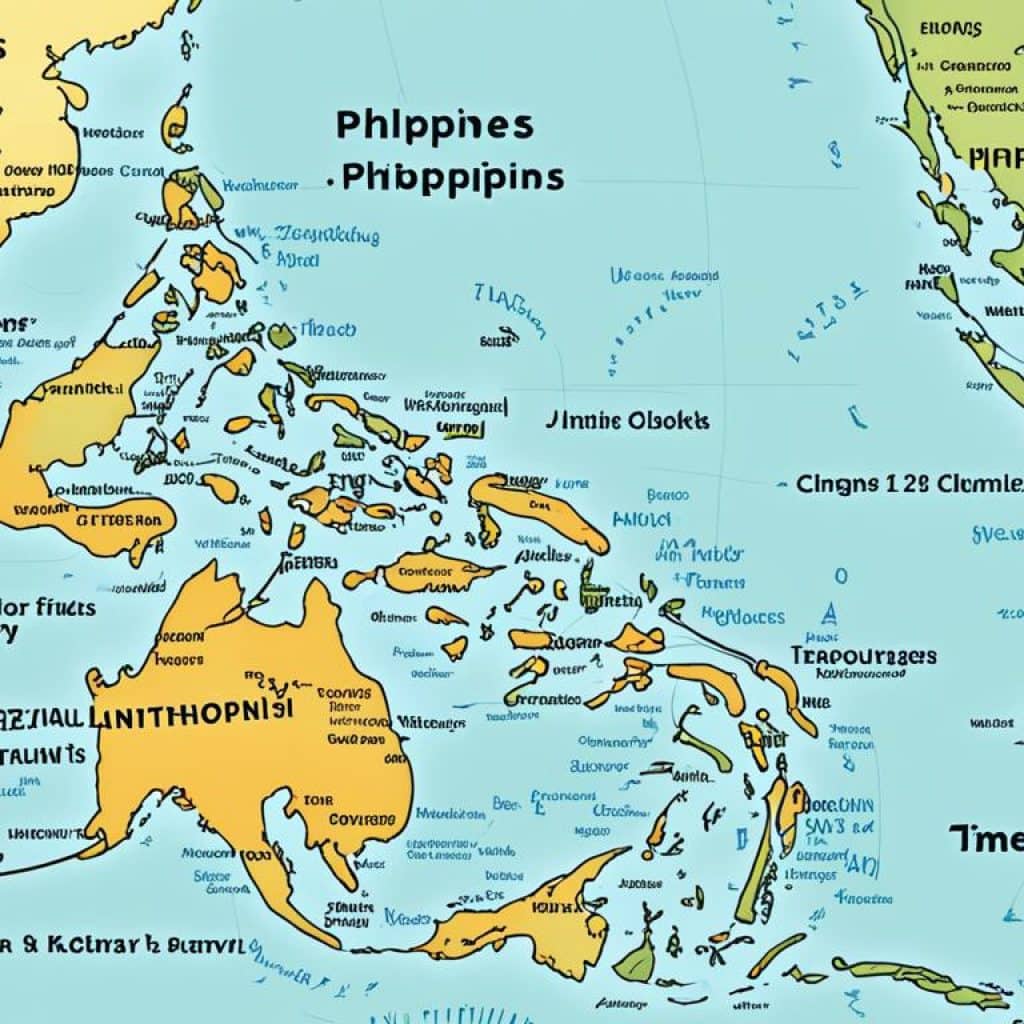Have you ever wondered why the Philippines operates on a different timezone compared to neighboring countries? How does this time difference impact various aspects of life, from personal communication to international business operations? Prepare to explore the fascinating world of timezones as we delve into the unique Philippine time zone and its implications.
Key Takeaways:
- The Philippines operates on Philippine Time (PHT), which is GMT+8 or UTC+8.
- The time difference between the Philippines and the United States varies across different time zones.
- Awareness of the time difference is crucial for effective communication in personal and professional settings.
- The time difference affects business operations, personal relationships, travel planning, and media consumption.
- Understanding time zones facilitates global coordination and synchronization.
Time Differences by US Time Zones reference to Philippines Time Zone
When it comes to coordinating across different time zones, understanding the time differences is crucial. Here is a reference guide for the time differences between the United States and the Philippines:
| US Time Zone | Time Difference |
|---|---|
| Eastern Standard Time (EST) | 12 hours behind |
| Central Standard Time (CST) | 13 hours behind |
| Mountain Standard Time (MST) | 14 hours behind |
| Pacific Standard Time (PST) | 15 hours behind |
| Alaska Standard Time (AKST) | 16 hours behind |
| Hawaii-Aleutian Standard Time (HAST) | 18 hours behind |
It’s important to keep this time difference in mind when scheduling meetings, making travel plans, or arranging any time-sensitive activities between the US and the Philippines.
Fun Fact:
Did you know that the Philippines shares its Standard Time (PHT) with China, Taiwan, Malaysia, and Singapore?
Planning and communication are key to overcoming the challenges posed by time differences, ensuring that both sides can effectively collaborate and stay connected.
Implications of the Time Difference
The time difference between the US and the Philippines has far-reaching implications across various aspects of life. Whether it’s for business and work, personal communication, travel, or media and entertainment, understanding the time zone disparity is essential for effective interactions.
1. Business and Work
Companies operating between the US and the Philippines face unique challenges when it comes to scheduling meetings, coordinating projects, and meeting deadlines. The significant time difference of approximately 12 hours between major US cities and the Philippines can make real-time collaboration difficult. It may require flexible working hours and careful planning to ensure smooth business operations.
2. Personal Communication
For families, friends, and loved ones residing in different time zones, maintaining regular communication becomes a thoughtful exercise. To connect across the Pacific, individuals must consider the time gap and organize calls, video chats, and virtual meetups accordingly. Respecting each other’s local time is essential to foster strong personal relationships.
3. Travel
Planning travel between the US and the Philippines involves adapting to the time difference, which can affect the body’s circadian rhythm and lead to jet lag. Travelers need to adjust their schedules and plan activities post-arrival accordingly. Being mindful of the time zone disparity helps minimize the effects of jet lag and optimize travel experiences.
4. Media and Entertainment
Consuming media and entertainment content poses a unique challenge due to the time difference between the US and the Philippines. Live events, TV shows, or sports broadcasts originating from the US are often aired at considerably different times in the Philippines, impacting viewership and fan engagement. Dedicated fans may need to adjust their daily routines or set alarms to catch their favorite programs in real-time.
“The time difference between the US and the Philippines brings both challenges and opportunities. By embracing technology and adopting flexible approaches, individuals and businesses can harness the advantages of a globalized world.”
In conclusion, the time difference between the US and the Philippines influences various aspects of life, from business and personal communication to travel and media. It requires strategic planning, adaptability, and understanding to overcome the challenges and maximize the advantages that come with international connectivity.
| Aspect | Implications |
|---|---|
| Business and Work | Challenges in real-time collaboration and scheduling. |
| Personal Communication | The need for synchronized communication across time zones. |
| Travel | Adjusting to time differences and overcoming jet lag. |
| Media and Entertainment | Differences in live event timings and viewership. |
Business and Work
Companies operating between the US and the Philippines face the challenge of managing the time difference in order to ensure smooth business operations. The time zone variance of Timezone In The Philippines poses unique considerations for scheduling meetings and meeting deadlines. It requires careful coordination and flexibility.
Real-time collaboration between teams in the US and the Philippines can be particularly challenging due to the significant Time difference in the Philippines. However, with effective planning and communication, companies can overcome these obstacles and foster successful partnerships.
Businesses that operate across borders often need to establish communication protocols and working arrangements that accommodate both parties. Flexible working hours may be necessary to enable effective collaboration and timely responses.
“Effective communication and adaptability are essential for businesses conducting operations between the US and the Philippines. By understanding and respecting the timezone differences, companies can establish productive working relationships and enhance their global reach.”
In addition to scheduling considerations, other factors such as cultural differences, holidays, and local customs should also be taken into account when doing business across time zones.
Despite the challenges, the timezone In The Philippines also provides unique opportunities for businesses engaged in global operations. The Timezone In The Philippines offers the advantage of starting the workday ahead of many other regions, allowing for early progress and potential synergies with international counterparts.
Managing Business Operations Across Time Zones
Effective management of business operations between the US and the Philippines requires careful planning and communication. Here are some tips to navigate the time difference:
- Establish regular communication channels: Use various tools and technologies to facilitate smooth communication and collaboration across time zones. This can include video conferencing, project management software, and instant messaging platforms.
- Set clear expectations: Ensure that all team members understand the time difference and establish guidelines for response times and availability. Clarity and transparency are crucial for managing expectations and avoiding misunderstandings.
- Consider overlap hours: Identify common time frames where both teams can be available for meetings and discussions. This may require adjusting schedules or working flexibly to accommodate different time zones.
- Prioritize tasks and deadlines: Plan and prioritize tasks to account for the time difference and ensure that essential activities are scheduled at suitable times for both teams. This includes setting realistic deadlines and allowing time for review and feedback.
- Encourage cultural sensitivity: Foster an inclusive and understanding work environment that acknowledges and appreciates cultural differences. This can help create a harmonious and productive collaboration across borders.
By implementing these strategies and maintaining open lines of communication, businesses can successfully navigate the time difference between the US and the Philippines, enabling efficient business operations and fostering mutually beneficial partnerships.
Personal Communication
Staying connected with loved ones who are spread across different time zones can require some planning and consideration. When it comes to communication between the United States and the Philippines, the time difference becomes a crucial factor.
Whether you want to catch up with family members or have a video chat with friends, understanding the time gap is essential. The time difference in the Philippines, being UTC+8, means that if it’s morning in the US, it’s already evening in the Philippines.
Coordinating your calls or video chats while considering the time difference helps ensure that both parties are available and awake for the conversation. It allows for meaningful connections and eliminates the possibility of disturbing someone’s sleep or interrupting important tasks.
“Distance means so little when someone means so much.”
Personal communication is key to nurturing relationships, and despite the time difference, it’s important to find common moments to connect with the people who matter most. Planning ahead and being considerate of each other’s schedules can create a stronger bond and make every conversation more special.
Tips for Effective Communication across Time Zones:
- Set regular communication schedules and stick to them.
- Use messaging apps to leave thoughtful messages that can be read and replied to at any time.
- Consider using tools like calendar invites to schedule video calls in advance.
- Be understanding and flexible if plans need to change due to unforeseen circumstances or conflicting time commitments.
- Make an effort to accommodate each other’s time zones by adjusting your own schedule if possible.
- Support each other’s routines and commitments, respecting the need for rest and personal time.

Travel
When traveling between the United States and the Philippines, it is important to consider the time difference. The time difference in the Philippines can lead to jet lag, which can affect your energy levels and sleep patterns. By understanding the time zones, you can plan your flights and activities post-arrival more effectively.
Adjusting to the time difference is crucial to avoid feeling disoriented during your trip. It is recommended to gradually adjust your sleep schedule a few days before your departure. This can help your body adapt to the new time zone more smoothly.
During the flight between the US and the Philippines, it can be helpful to adjust your watch or phone to the local time of your destination. This will give you a sense of the current time in the Philippines and help you align your activities accordingly.
Once you arrive in the Philippines, it’s important to maintain a regular sleep schedule to help your body adjust to the new time zone. Exposure to natural light during the day can also aid in regulating your body’s internal clock.
When planning your itinerary, consider the local time in the Philippines for sightseeing, dining, and other activities. Be aware of the opening and closing times of attractions, restaurants, and public transportation to avoid any inconvenience.
Key Tips for Traveling Between the US and the Philippines:
- Gradually adjust your sleep schedule before departure
- Adjust your watch or phone to the local time of your destination during the flight
- Maintain a regular sleep schedule upon arrival in the Philippines
- Expose yourself to natural light during the day
- Consider local time when planning your activities and itinerary
By taking these steps to understand and adapt to the time difference, you can make the most of your travel experience between the US and the Philippines.
Media and Entertainment
When it comes to media and entertainment, the time difference between the United States and the Philippines can have a significant impact. Live events, TV shows, and sports broadcasts happening in the US are often aired at very different times in the Philippines. This time gap affects viewership and fan participation, as Filipino fans may have to adjust their schedules or find alternative ways to watch their favorite programs.
For example, popular TV shows like Game of Thrones or The Walking Dead that air in the evening in the US may be shown in the early morning hours in the Philippines. This can make it challenging for fans to watch the episodes live and participate in discussions or live-tweeting.

However, this time difference also opens up opportunities for fans to come together and create communities around their favorite shows. Social media platforms allow fans to connect and share their thoughts, theories, and reactions even if they can’t watch the content simultaneously.
Additionally, streaming services like Netflix or Hulu have made it easier for Filipino viewers to catch up on their favorite US shows at their convenience. They can watch episodes at any time and avoid spoilers by staying off social media until they’ve caught up.
Impact on Sports
The time difference also plays a role in sports events. Major sporting events like the Super Bowl or the NBA Finals, which often take place in the evening in the US, may be shown live in the early morning hours in the Philippines. This can make it challenging for Filipino sports fans to watch the games live and experience the excitement in real-time.
However, sports networks and local broadcasters in the Philippines often provide replays and highlights to cater to the local audience. This allows fans to still enjoy the sports events, even if they can’t watch them live.
“Watching my favorite NBA team play live in the US may mean waking up at odd hours, but the passion of the Filipino fans always shines through. We gather with friends, stay up late, or wake up early to support our teams. It’s a unique experience that brings us closer together,” says Michael, a basketball fan from Manila.
| Time (US Eastern Time) | Time (Philippine Time) |
|---|---|
| 8:00 PM | 8:00 AM (next day) |
| 10:00 PM | 10:00 AM (next day) |
| 1:00 PM | 1:00 AM (next day) |
While the time difference between the US and the Philippines can be challenging for media and entertainment consumption, it also brings communities together and showcases the resilience and dedication of Filipino fans. They find creative ways to stay connected to their favorite shows and sports events, ensuring that the enjoyment and excitement transcend time zones.
Conclusion
The time difference between America and the Philippines plays a significant role in the global landscape. It presents challenges that impact various aspects of life, such as business operations, personal relationships, and cultural exchanges. Navigating these differences effectively requires awareness and careful planning.
For businesses operating between the US and the Philippines, scheduling meetings and managing deadlines can be a complex task. Real-time collaboration may require flexible working hours to accommodate the time gap. However, with proper coordination and communication, organizations can find productive solutions that bridge the distance.
In personal communication, staying connected with loved ones across the Pacific means aligning schedules and planning ahead. Whether it’s arranging phone calls or video chats, being mindful of the time difference fosters stronger connections.
Travelers between the US and the Philippines must also consider the time difference when planning flights and adjusting to jet lag. Understanding the local time zones helps streamline travel arrangements and optimize the experience upon arrival.
Additionally, the time difference impacts media and entertainment consumption. Live events and TV shows happening in the US may air at different times in the Philippines, leading to adjustments in viewership and fan participation.
Overall, being aware of the time difference in the Philippines and embracing it as an integral part of global interactions enables smoother and more productive collaborations across the Pacific. With careful planning and coordination, individuals and organizations can bridge the gap and thrive in a world that operates across different time zones.
“Time is the scarcest resource and unless it is managed nothing else can be managed.” – Peter Drucker
History
The concept of time zones and standardized time developed as a means to synchronize timekeeping across different regions. It was essential to establish a universal reference point to ensure accurate time measurement and coordination. One significant milestone in the history of timekeeping is the establishment of Greenwich Mean Time (GMT) as the standard reference time.
The Royal Observatory in Greenwich, London, played a pivotal role in this development. The observatory was founded in 1675 by King Charles II to aid navigation at sea. Astronomers and scientists at the observatory conducted precise observations and calculations to determine the exact position of celestial bodies and establish accurate time measurements.
The Royal Observatory in Greenwich, London, played a significant role in establishing Greenwich Mean Time (GMT) as the standard reference time.
Greenwich Mean Time (GMT) served as the reference time for all other time zones around the world. It was based on solar time, determined by the position of the sun in relation to the Prime Meridian, which passes through Greenwich. The Prime Meridian was internationally adopted in 1884 as the zero-degree longitude.
The establishment of GMT and the concept of time zones revolutionized timekeeping and brought about more efficient global communication and coordination. It provided a standardized framework for scheduling and organizing activities on a regional and international scale.
The Role of Solar Time
Solar time, also known as apparent solar time, was the earliest form of timekeeping. It is based on the movement of the sun across the sky throughout the day. Solar time varies slightly each day due to the tilt of the Earth’s axis and its elliptical orbit around the sun.
Before the introduction of time zones, each location used its own solar time, which was determined based on the specific longitude of the area. This meant that neighboring towns and regions could have slightly different local times, leading to confusion and difficulties in coordinating schedules and travel.
The Need for Standardized Time
The increasing use of railways, telegraphs, and global trade necessitated the development of a standardized time system. It became crucial to have consistent time measurements to ensure efficient transportation scheduling, communication, and international commerce.
The widespread adoption of time zones and standardized time facilitated global synchronization and provided a common language for organizing activities and events around the world. Today, time zones are an integral part of our daily lives, enabling us to coordinate with people in different regions and plan our schedules effectively.

| Key milestones in the history of time zones | Date |
|---|---|
| Establishment of Greenwich Mean Time (GMT) | 1884 |
| Introduction of time zones in the United States | 1883 |
| Expansion of time zone system globally | 20th century |
| Development of Coordinated Universal Time (UTC) | 1972 |
Railway time
The introduction of railways revolutionized transportation systems, leading to the necessity of standardized time across different regions. Standardized timekeeping played a crucial role in ensuring efficient scheduling and coordination of train operations, resulting in a more organized and reliable railway network.
The implementation of standardized time allowed rail operators to establish consistent timetables, enabling passengers to accurately plan their journeys and ensuring that trains arrived and departed on time. Prior to standardized time, each location had its own local mean solar time, leading to inconsistencies and confusion, especially when coordinating train schedules across different regions.
With the adoption of standardized time, railway companies were able to effectively synchronize their operations with the help of accurate clocks and timetables. This improved efficiency, reduced delays, and enhanced overall system reliability.
In addition to facilitating railway operations, the concept of standardized time extended beyond the rail industry and had a profound impact on various aspects of daily life, such as business, communication, and societal coordination.
“The introduction of standardized time in railway operations was a pivotal moment in transportation history. It revolutionized the way trains operated, allowing for improved efficiency and coordination across vast distances.”
– John Stevenson, Railway Expert
List of UTC offsets
The world is divided into various time zones, each with its own UTC offset. The UTC offset represents the difference between Coordinated Universal Time (UTC) and local time in a specific region or country. This offset is expressed in hours and minutes, indicating whether the local time is ahead or behind UTC.
| UTC Offset | Timezone | Daylight Saving Time (DST) |
|---|---|---|
| UTC-12:00 | Baker Island, Howland Island | No DST |
| UTC-11:00 | American Samoa, Niue, Midway Atoll | No DST |
| UTC-10:00 | Hawaii, French Polynesia, Cook Islands | Some regions observe DST |
| UTC-9:00 | Alaska, Gambier Islands | Some regions observe DST |
| UTC-8:00 | Pacific Time Zone (USA and Canada), Baja California | Some regions observe DST |
| UTC-7:00 | Mountain Time Zone (USA and Canada), Sonora | Some regions observe DST |
| UTC-6:00 | Central Time Zone (USA and Canada), Mexico City | Some regions observe DST |
| UTC-5:00 | Eastern Time Zone (USA and Canada), Bogota, Lima | Some regions observe DST |
| UTC-4:00 | Atlantic Time Zone (Canada), Caracas, Santiago | Some regions observe DST |
| UTC-3:30 | Newfoundland Time Zone (Canada) | Some regions observe DST |
| UTC-3:00 | Brasilia, Buenos Aires, Montevideo | Some regions observe DST |
| UTC-2:00 | South Georgia and the South Sandwich Islands | No DST |
| UTC-1:00 | Azores, Cape Verde Islands | Some regions observe DST |
| UTC+0:00 | Greenwich Mean Time (GMT), Dublin, London | Some regions observe DST |
| UTC+1:00 | Central European Time (CET), Paris, Rome | Some regions observe DST |
| UTC+2:00 | Eastern European Time (EET), Cairo, Athens | Some regions observe DST |
…content continued…
…content continued…
…content continued…
Areas of extreme latitude and DST
Areas of extreme latitude, such as regions in the northern and southern hemispheres, often experience drastic changes in daylight hours throughout the year. To make better use of daylight during specific parts of the year, many of these regions practice Daylight Saving Time (DST). DST is a practice that involves adjusting the clocks forward by one hour during the summer months to extend daylight into the evening.
DST is typically observed for about half of the year, with the clocks being set back to standard time during the winter months. By adding an additional hour to the local time, these areas can maximize daylight and better align their schedules with the changing seasons.
One example of a country that practices DST is the Philippines. Despite not being located at extreme latitudes, the Philippines follows DST to take advantage of daylight during certain months. This observation of DST helps ensure that the local time remains synchronized with neighboring countries and facilitates efficient coordination across time zones.
Conclusion
Understanding the time difference in the Philippines and practicing timezone observance is essential for effective global communication and coordination. Timezones play a crucial role in facilitating efficient scheduling and ensuring synchronization across different regions of the world.
By being aware of the time difference in the Philippines and other countries, individuals and businesses can plan their activities and interactions accordingly, avoiding confusion and missed opportunities. Global time synchronization allows for seamless collaboration and coordination, regardless of geographical barriers.
Whether it’s scheduling virtual meetings, staying in touch with loved ones overseas, or planning international travel, considering the time difference and adhering to timezone observance helps maintain smooth interactions and avoids inconveniences caused by mismatched schedules. It ensures that everyone involved can make the most of their time and maximize productivity.


















Add comment